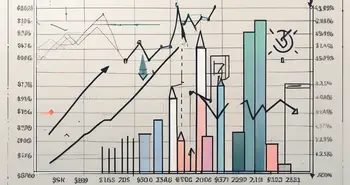Understanding the Rule of 72: A Simple Guide to Doubling Your Money

Welcome to my comprehensive guide on the Rule of 72, a powerful tool for doubling your money. As an experienced financial expert, I'll walk you through the concept, application, limitations, and benefits of this rule. So let's dive in and enhance your financial literacy with the Rule of 72!
The Concept of the Rule of 72
At its core, the Rule of 72 is a quick and simplified way to estimate how long it takes for your investment to double based on a fixed annual rate of return. The Rule of 72 states that by dividing 72 by the annual interest rate, you can determine the approximate number of years it would take for your investment to double.
For example, if you have an investment earning an annual return of 8%, you can estimate that it will take approximately 9 years for your investment to double (72 divided by 8 equals 9).
But let's dive deeper into the concept of the Rule of 72 and explore its mathematical foundation, as well as its importance in the world of finance.
The Mathematical Foundation of the Rule of 72
The Rule of 72 is derived from the natural logarithm. Although the derivation requires a bit of mathematical prowess, the end result is a simple formula that anyone can use to get a quick estimation of their investment's growth potential.
The rule assumes compound interest and is valid for interest rates ranging from 2% to 20%. While it may not provide exact precision, it's an invaluable tool for making rough calculations about your financial goals.
By using logarithmic calculations, the Rule of 72 takes into account the compounding effect of interest, which allows your investment to grow exponentially over time. This compounding effect is what makes the Rule of 72 such a powerful tool for investors.
The Importance of the Rule of 72 in Finance
Understanding the Rule of 72 is essential because it empowers you to make informed decisions about your investments. By using this rule, you can quickly assess the potential returns of different investment opportunities and determine if they align with your financial objectives.
Furthermore, the simplicity of the Rule of 72 makes it approachable for individuals with varying levels of financial literacy. Whether you're new to investing or a seasoned pro, this tool can help you gauge the power of compounding interest.
Moreover, the Rule of 72 can be a valuable tool for financial planning. It allows you to estimate how long it will take for your investments to double, which can help you set realistic goals and timelines for achieving your financial milestones.
Additionally, the Rule of 72 can be used to compare different investment options. By applying the rule to various interest rates, you can quickly determine which investment has the potential to grow your wealth at a faster pace.
Overall, the Rule of 72 is a simple yet powerful concept that can assist you in making informed financial decisions. Whether you're saving for retirement, planning for a major purchase, or simply looking to grow your wealth, understanding the Rule of 72 can be a valuable asset in your financial toolkit.
Applying the Rule of 72 in Real-Life Scenarios
Now that you grasp the concept, let's explore practical applications of the Rule of 72.
The Rule of 72 is a simple yet powerful tool that can be used in various financial scenarios. By understanding how it works, you can make more informed decisions about investments and retirement planning.
Using the Rule of 72 for Investment Decisions
When contemplating investments, the Rule of 72 allows you to compare different options quickly. Suppose you have two investment opportunities: one offering an average annual return of 6% and the other 10%. By applying the Rule of 72, you can see that the investment with a 6% return will take approximately 12 years to double, while the 10% return investment will double in around 7 years.
This information can be invaluable when deciding where to allocate your funds. It helps you understand the time it will take for your investments to grow and the potential returns you can expect. Armed with this knowledge, you can make informed decisions about which investment aligns best with your financial goals and time horizon.
The Rule of 72 in Retirement Planning
Retirement planning is another area where the Rule of 72 shines. Let's say you're 30 years old and have $50,000 saved for retirement. Using the Rule of 72, you can estimate how long it will take for that money to double based on different growth rates.
If you have a retirement portfolio that earns an average annual return of 5%, you can estimate your money will double in approximately 14 years, giving you $100,000 by the time you're 44 years old.
However, by increasing the average annual return to 10%, you can expect your retirement savings to double in just 7 years, putting you on track to have $100,000 by the time you're 37 years old.
This example highlights the power of compounding interest and the impact it can have on your retirement savings. The Rule of 72 allows you to visualize the growth potential of your investments and make strategic decisions to maximize your savings.
Keep in mind that the Rule of 72 is a simplified estimation and doesn't account for factors such as inflation, taxes, and market volatility. It's essential to consult with a financial advisor or conduct thorough research before making any investment or retirement planning decisions.
Limitations and Misconceptions of the Rule of 72
While the Rule of 72 is a valuable tool, it is not without its limitations and misconceptions.
The Rule of 72 is a simple formula used to estimate the time it takes for an investment to double based on a fixed annual return. However, there are some common misunderstandings about this rule that are important to address.
Common Misunderstandings about the Rule of 72
One common misconception is that the Rule of 72 provides the exact time it takes for an investment to double. While it provides a close estimate, it's important to remember that the rule assumes a fixed annual return. In reality, market conditions can fluctuate, resulting in different annual returns.
For example, if you have an investment with an annual return of 8%, the Rule of 72 estimates that it will take approximately 9 years for your investment to double. However, if the annual return fluctuates between 6% and 10% over those 9 years, the actual time it takes for your investment to double will vary.
Additionally, the Rule of 72 only applies to compound interest and doesn't consider other factors that can influence investment returns, such as inflation or taxes. These factors can significantly impact the growth of your investment and should be taken into account when making financial decisions.
When the Rule of 72 Doesn't Apply
It's crucial to note that the Rule of 72 is most accurate when applied to moderate interest rates between 2% and 20%. For interest rates outside this range, the approximation becomes less reliable.
For example, if you have an investment with an annual return of 1%, the Rule of 72 estimates that it will take approximately 72 years for your investment to double. However, due to the low interest rate, it may take much longer for your investment to actually double.
Moreover, the Rule of 72 is designed for long-term investments. For short-term investments or those with high volatility, it's advisable to seek more precise calculations or consult with a financial advisor.
For instance, if you are considering a short-term investment with a high annual return, such as a speculative stock, the Rule of 72 may not provide an accurate estimate of when your investment will double. The volatility of the stock market can greatly affect the growth of your investment, making it difficult to rely solely on the Rule of 72.
Therefore, it's important to consider the limitations of the Rule of 72 and use it as a rough guideline rather than an exact calculation. By understanding its constraints and seeking additional information, you can make more informed decisions about your investments.
Enhancing Your Financial Literacy with the Rule of 72
Now that you understand the ins and outs of the Rule of 72, it's time to put this knowledge into action to improve your financial future.
But what exactly is the Rule of 72? It is a simple and powerful formula that allows you to estimate the time it will take for your money to double at a given interest rate. By dividing 72 by the interest rate, you can quickly determine how many years it will take for your investment to double in value. This rule is widely used in the world of finance and investing, and by mastering it, you gain a valuable tool for evaluating investment opportunities, setting realistic financial goals, and making informed decisions.
With this knowledge, you'll be better equipped to create a comprehensive financial plan that maximizes your investment returns and helps you achieve your desired financial milestones.
The Role of the Rule of 72 in Financial Education
Financial education is crucial in today's complex and ever-changing world. By understanding the Rule of 72, you are taking a significant step towards improving your financial literacy. This rule serves as a foundation for understanding compound interest and the time value of money.
By grasping the concept behind the Rule of 72, you'll be able to navigate the financial landscape with confidence. You'll have the ability to assess investment opportunities, analyze the potential risks and rewards, and make informed decisions that align with your financial goals.
Moreover, the Rule of 72 is not limited to investments alone. It can be applied to various aspects of personal finance, such as calculating the impact of inflation on your savings or estimating the time it will take for your debt to double if left unchecked.
How the Rule of 72 Can Improve Your Financial Future
Imagine a future where you can confidently assess the growth potential of your investments without relying solely on financial advisors or complex calculations. With the Rule of 72, that future becomes a reality.
By empowering yourself with financial literacy and a solid understanding of the Rule of 72, you'll be more confident in making investment decisions, spotting potentially profitable opportunities, and steering your financial future toward success.
Furthermore, the Rule of 72 can help you set realistic financial goals. By knowing how long it takes for your money to double, you can plan for major life events such as buying a house, funding your children's education, or saving for retirement. This knowledge allows you to make informed choices about how much to save and how to allocate your resources.
Additionally, the Rule of 72 can serve as a benchmark for evaluating the performance of your investments. If an investment is not meeting the expected doubling time, it may be a sign to reevaluate your strategy and consider alternative options.
In conclusion, the Rule of 72 is a powerful tool that can enhance your financial literacy and improve your financial future. By understanding and applying this rule, you'll be better equipped to make informed decisions, set realistic goals, and navigate the complex world of finance with confidence.
FAQs
What is the Rule of 72?
The Rule of 72 is a simplified calculation that estimates how long it will take for an investment to double based on a fixed annual rate of return. By dividing 72 by the annual interest rate, you can determine the approximate number of years it would take for your investment to double.
For example, let's say you have an investment with an annual interest rate of 8%. By dividing 72 by 8, you find that it would take approximately 9 years for your investment to double.
The Rule of 72 is a handy tool that can give you a quick estimate of the time it would take for your investments to grow.
Is the Rule of 72 accurate?
While the Rule of 72 provides a close approximation, it's important to remember that it assumes a fixed annual rate and compound interest. Market fluctuations, inflation, and taxes can influence investment returns, making the rule less precise in certain situations.
It's always a good idea to consider other factors and consult with a financial advisor to get a more accurate picture of your investment growth potential.
Can the Rule of 72 be used for short-term investments?
The Rule of 72 is most accurate when applied to long-term investments that involve compound interest. For short-term investments or those with high volatility, it's advisable to seek more precise calculations or consult with a financial advisor.
Short-term investments often have different factors at play, such as fluctuating interest rates or market conditions, which can make the Rule of 72 less reliable. It's important to consider the specific characteristics of your investment before applying this rule.
How can I use the Rule of 72 in retirement planning?
To use the Rule of 72 in retirement planning, you can estimate how long it will take for your current retirement savings to double at different average annual returns. By assessing various growth rates, you can make informed decisions about how much to save and how long it will take to reach your retirement goals.
For example, if you have $100,000 in retirement savings and you expect an average annual return of 6%, you can use the Rule of 72 to estimate that your savings will double in approximately 12 years.
By using the Rule of 72 as a starting point, you can create a retirement plan that aligns with your financial goals and helps you make the most of your savings.
What are the limitations of the Rule of 72?
The Rule of 72 has limitations. It's most accurate for moderate interest rates between 2% and 20%. Outside this range, the approximation becomes less reliable. Additionally, the rule assumes compound interest and doesn't account for other factors like inflation or taxes.
For example, if you have an investment with an annual interest rate of 1%, using the Rule of 72 would estimate that it would take 72 years for your investment to double. However, this may not be accurate due to the low interest rate and other factors that can affect your investment growth.
Remember, mastering the Rule of 72 is just one step towards achieving your financial goals. Always strive to educate yourself further and consult with professionals to make well-informed financial decisions.
Now armed with the knowledge of the Rule of 72, go forth and double your money!
Ready to put the Rule of 72 into action and potentially double your money with innovative investment opportunities? Look no further than Morpher, the revolutionary trading platform that leverages blockchain technology for a unique, fee-free trading experience. Whether you're interested in stocks, cryptocurrencies, or even niche markets like NFTs, Morpher offers the flexibility of fractional investing, the advantage of short selling without interest fees, and up to 10x leverage to amplify your trades. Embrace the future of investing with Morpher's safe, user-centric platform and start with an edge. Sign Up and Get Your Free Sign Up Bonus today to transform your trading experience!

Disclaimer: All investments involve risk, and the past performance of a security, industry, sector, market, financial product, trading strategy, or individual’s trading does not guarantee future results or returns. Investors are fully responsible for any investment decisions they make. Such decisions should be based solely on an evaluation of their financial circumstances, investment objectives, risk tolerance, and liquidity needs. This post does not constitute investment advice.

Painless trading for everyone
Hundreds of markets all in one place - Apple, Bitcoin, Gold, Watches, NFTs, Sneakers and so much more.

Painless trading for everyone
Hundreds of markets all in one place - Apple, Bitcoin, Gold, Watches, NFTs, Sneakers and so much more.









